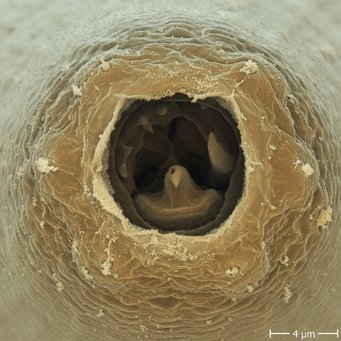Nematode Teeth Consist Of Chitin
Genetically modified worms may make us rethink invertebrate evolution
Genetically modified worms may make us rethink invertebrate evolution
Researchers at the Max Planck Institute for Biology in Tübingen have produced the first sound evidence that the teeth of the nematode Pristionchus pacificus consist of chitin. In doing so, they not only answer the long-standing question of the teeth composition, but also open up new perspectives on the evolution of the up to 10 million different nematode species. Their results now appear in the journal Current Biology.

A Pristionchus pacificus nematode showing its teeth.
© Jürgen Berger/MPI for Biology
Nematodes populate virtually the entire surface of the Earth, from marine trenches to deserts and high mountains. A mere square meter of soil can harbor more than a million of the tiny organisms which are often only a few millimeters in length; and it is estimated that around 80 percent of all multicellular animals are nematodes.
Despite their ubiquity and their importance for various ecosystems, many questions about the little worms are still unanswered, among others about the composition and development of their multiform mouth structures. It was, for example, hitherto unknown what the teeth that many nematode species possess are made of.
A lack of chitin causes mouth malformations
A research team at the Max Planck Institute for Biology in Tübingen, led by Ralf Sommer, has now for the first time shown conclusively that the teeth of the nematode Pristionchus pacificus consist of chitin. Chitin is a very resistant polysaccharide often used by nature to form durable structures: it is the building material for arthropod exoskeletons such as beetle carapaces and crustacean shells, and is also present in fungal cell walls.
It has been suspected since the 1940s that chitin could also be an important component in the mouth structure of nematodes. However, chitin is difficult to detect, so that its presence in nematode mouths could never be unequivocally demonstrated. Therefore, Ralf Sommer's team chose a different approach: the researchers used the CRISPR-CAS9 gene editing method to switch off one of the nematode's two genes responsible for chitin production. Depending on where the gene was altered, the mutants were either not viable at all – or their mouths were toothless and malformed. In addition, the researchers injected a substance preventing chitin production into genetically unaltered worms. With similar results: these individuals also possessed malformed mouths without teeth. "Together, the two experiments provide convincing evidence that chitin plays an important role for the worms’ teeth," summarizes Shuai Sun, first author of the study.
Unsuccessful predators without teeth
These findings are particularly relevant because the mouth structure is of paramount importance for nematodes; it determines the worm's mode of life. Early in life, animals of the species Pristionchus pacificus develop one of two species-specific mouth forms, which either allows them to predate on other nematodes or restricts them to a bacteria-based diet. The genetically modified worms from Sommer’s lab can feed on bacteria without issue, but their malformed mouths are not suited for a predatory lifestyle. This does, however, not prompt them to adapt their behavior to their limited abilities: the researchers were able to capture on camera how the toothless worms unsuccessfully tried to eat larvae of other nematodes.
Most important macromolecule for the diversification of invertebrates
The chitin study may be a starting point for a fresh look on the evolution of nematodes. Nematodes exhibit enormous diversity, being probably the most species-rich group in the animal kingdom, even surpassing insects: only 30 000 of the estimated up to 10 million different species have been described so far. The multiform, complex mouths of the various nematode species are fine-tuned to their respective ways of life and ecological niches. Hence, the new findings about the teeth composition might stimulate evolutionary studies. "We now suspect that chitin is enormously important for the differentiation of nematode mouth structures during evolution," Sun says. "If this turns out to be true, we could justifiably call chitin the most important macromolecule for the diversification of invertebrates."
Publication: Shuai Sun, et al., Chitin contributes to the formation of a feeding structure in a predatory nematode, Current Biology (2022). DOI: 10.1016/j.cub.2022.11.011.
Original Story Source: Max Planck Institute for Biology

 Alerts Sign-up
Alerts Sign-up